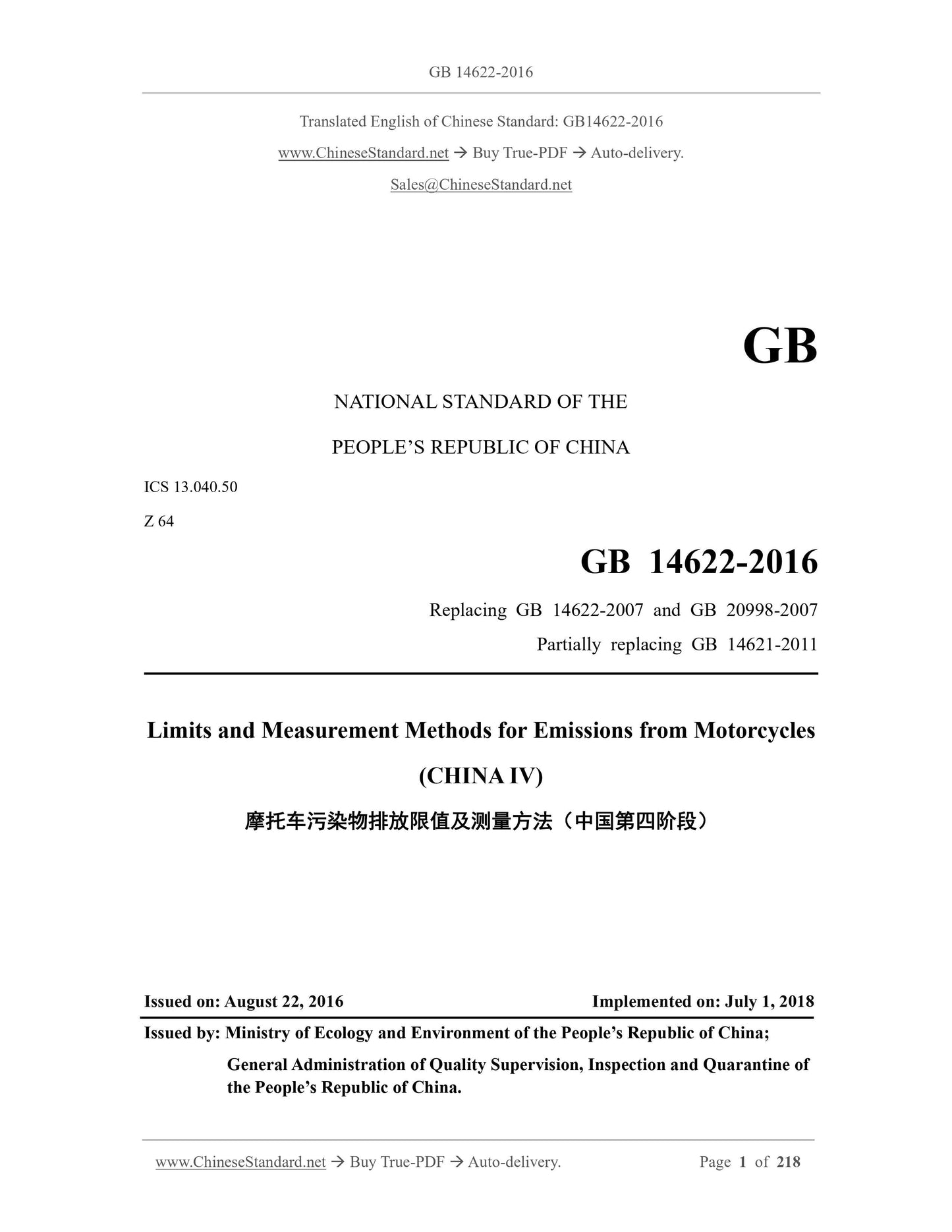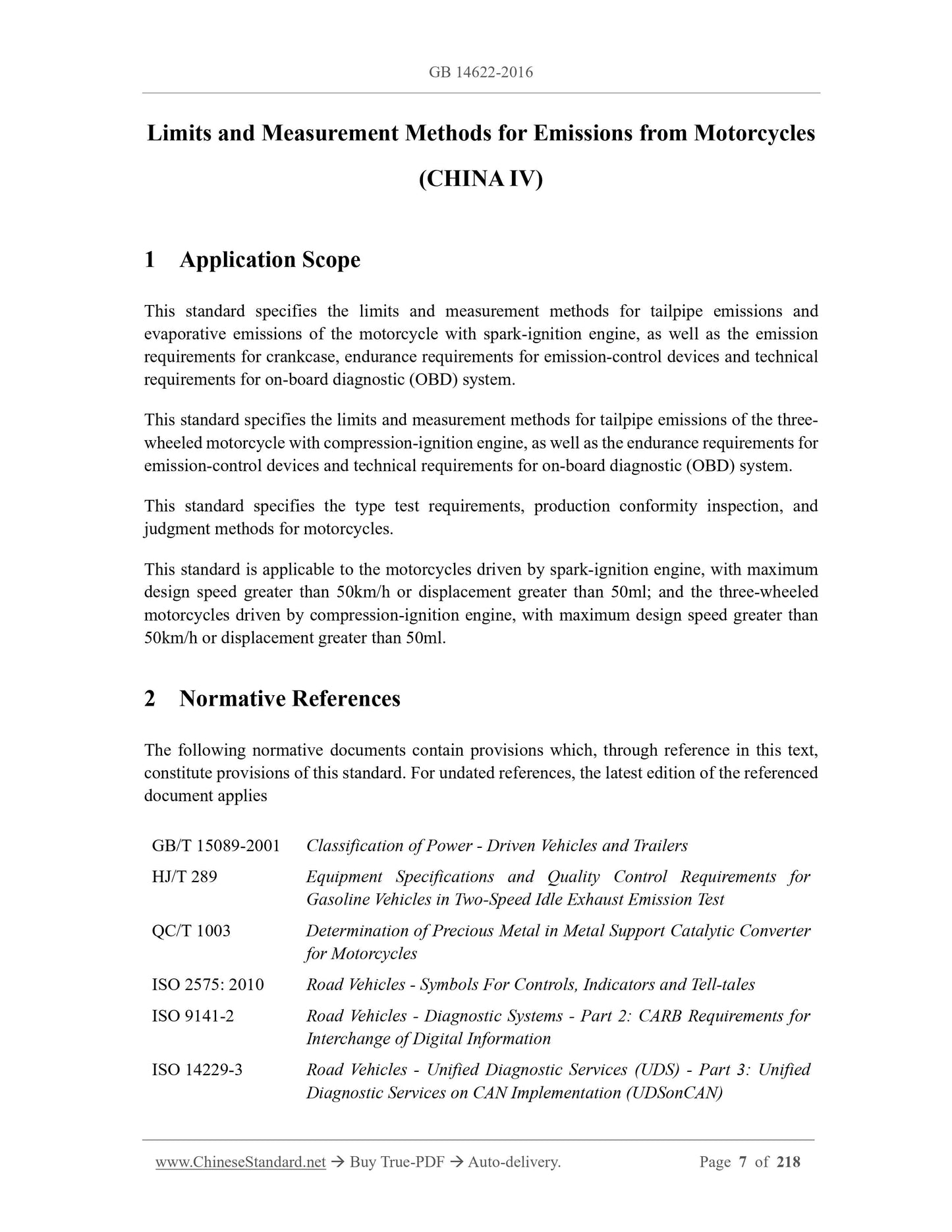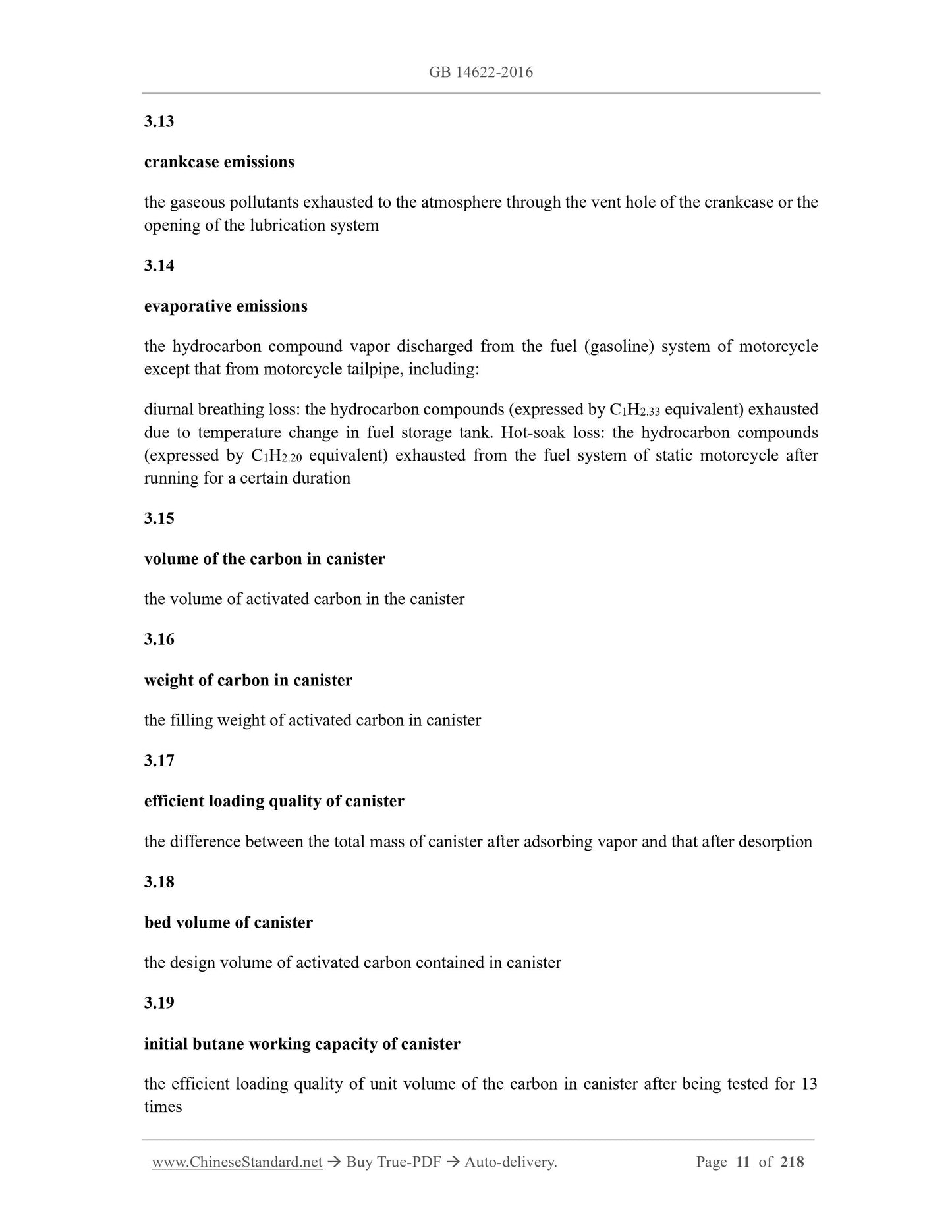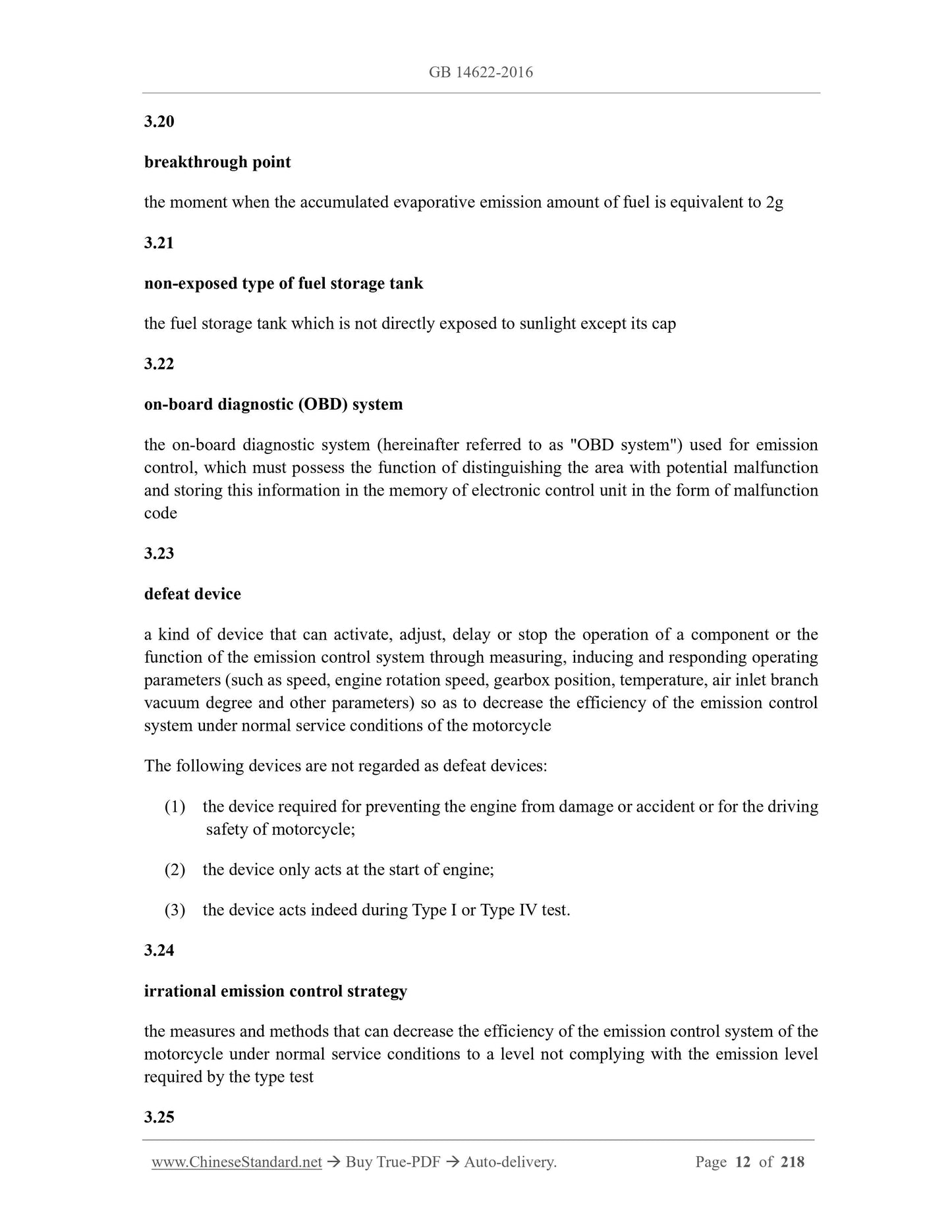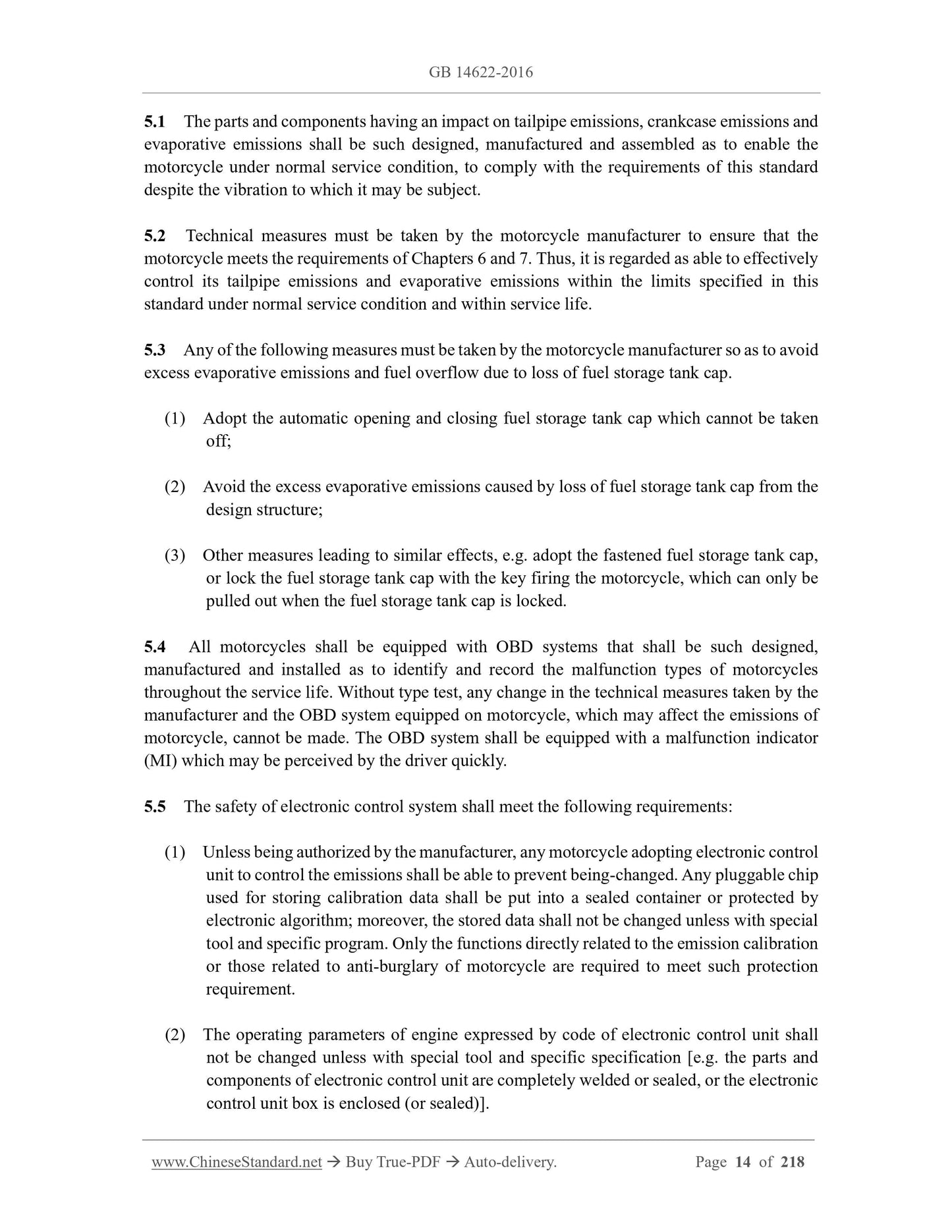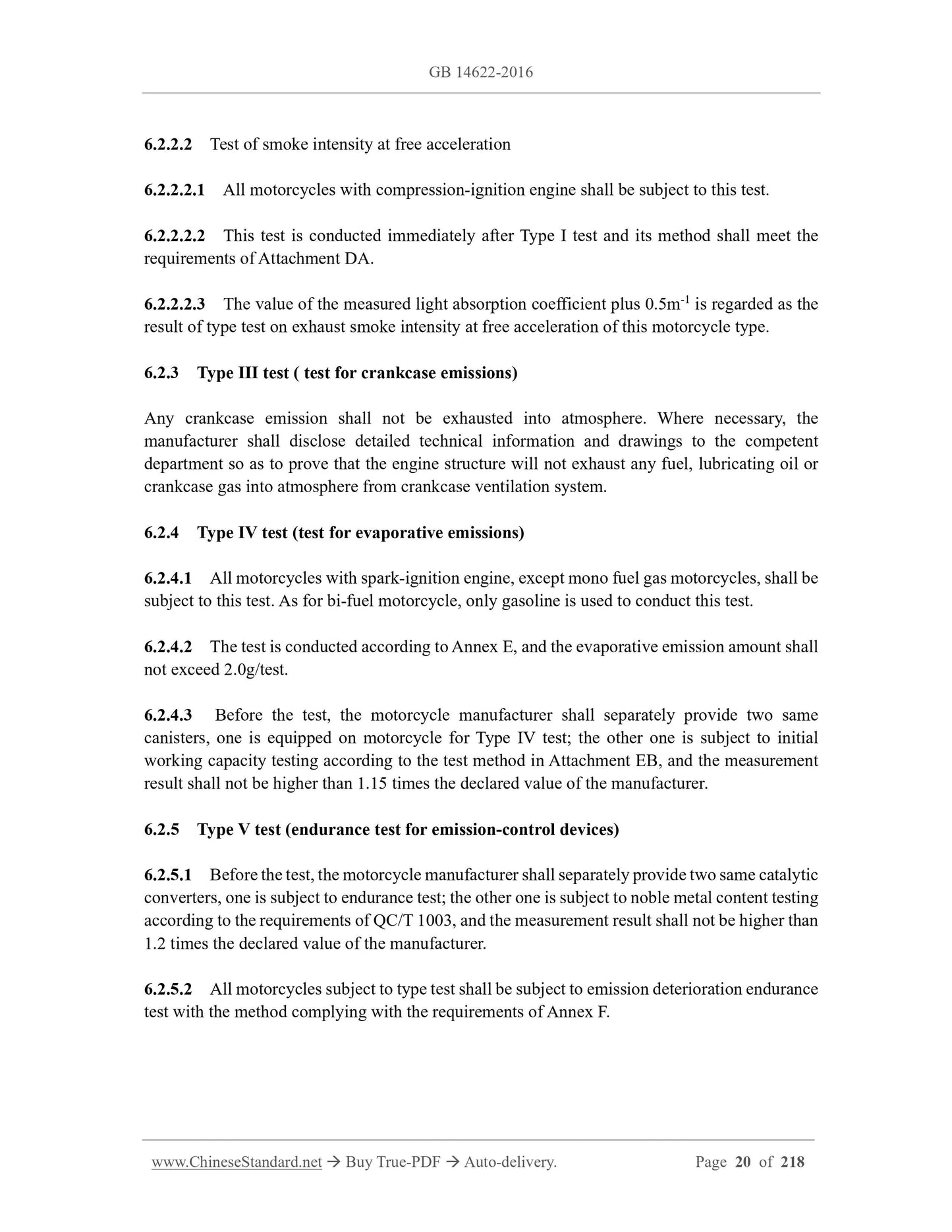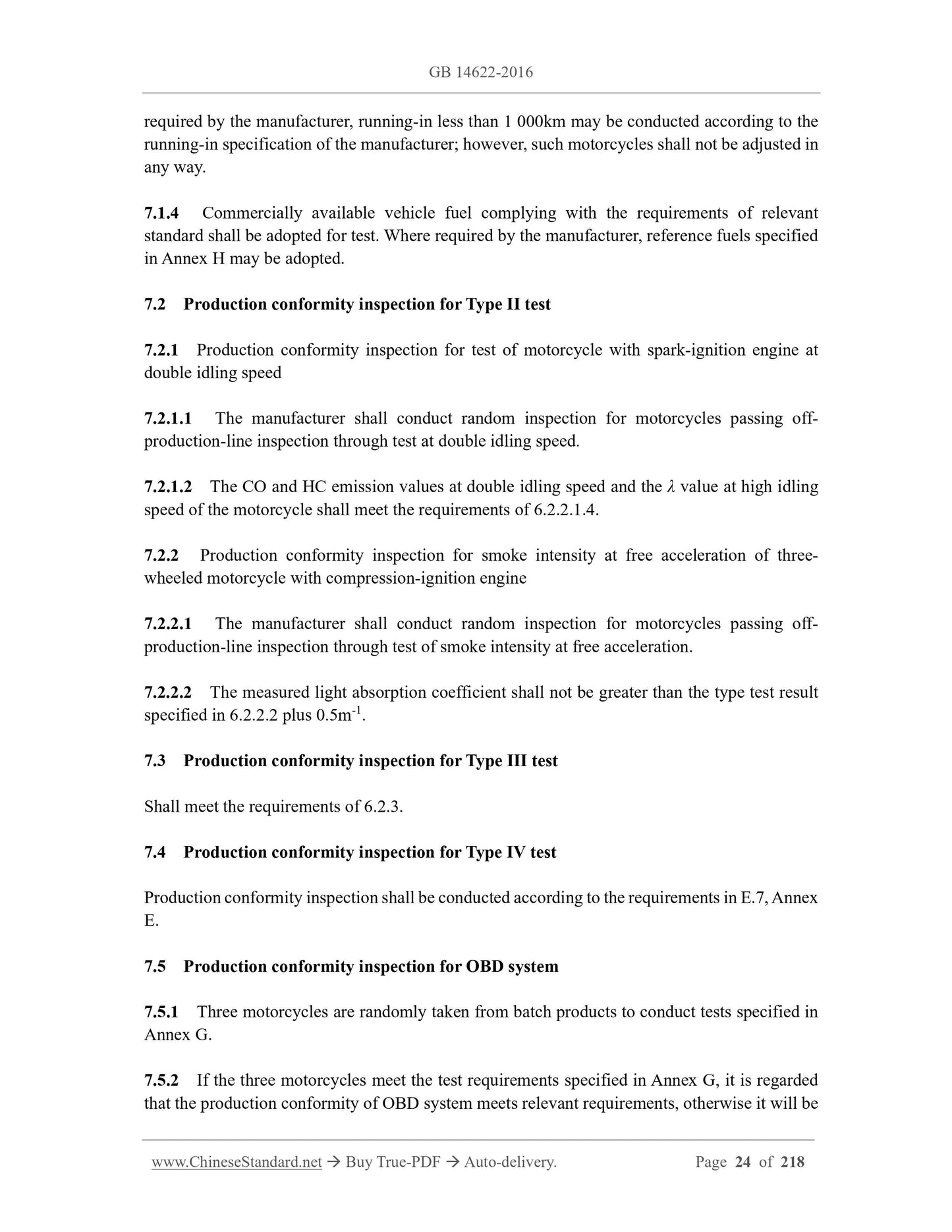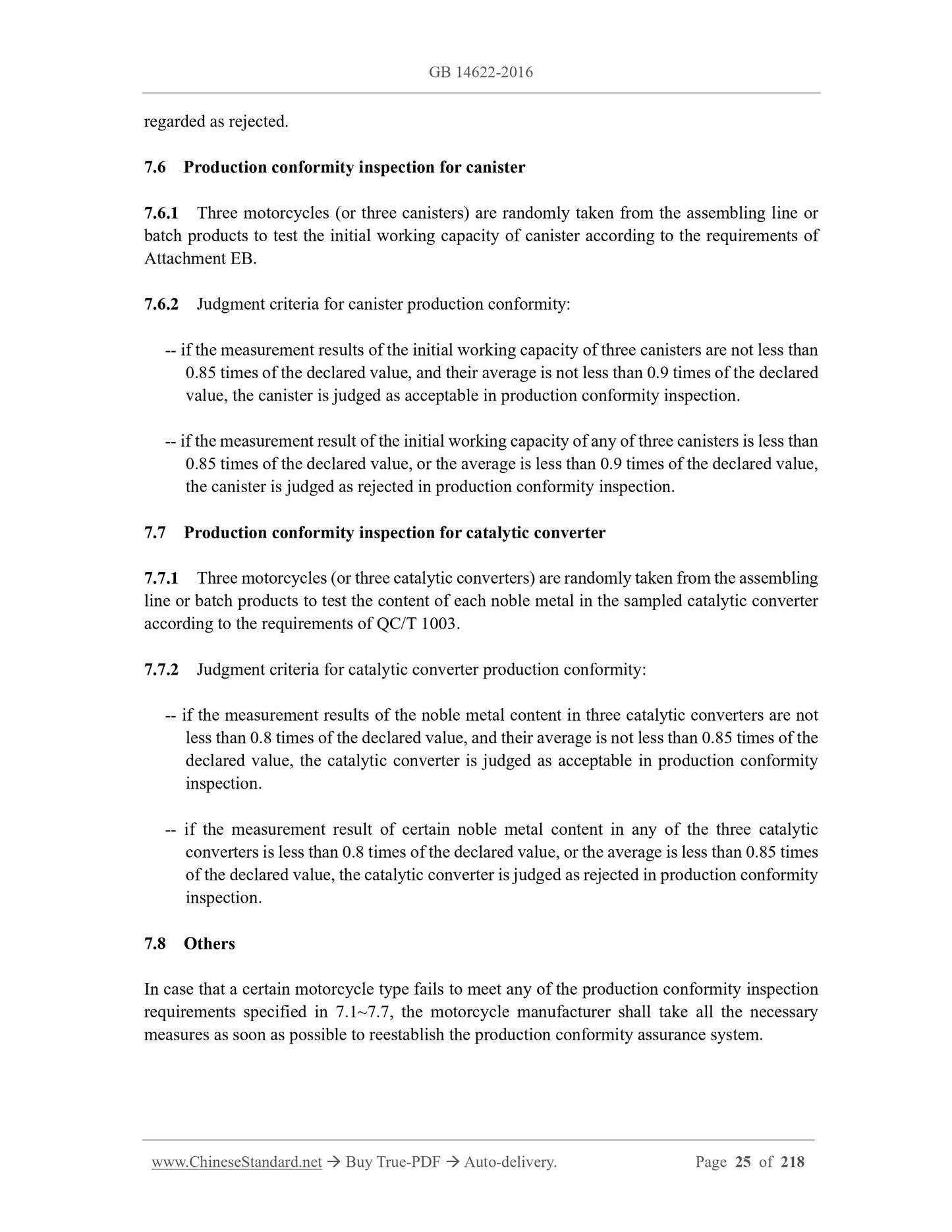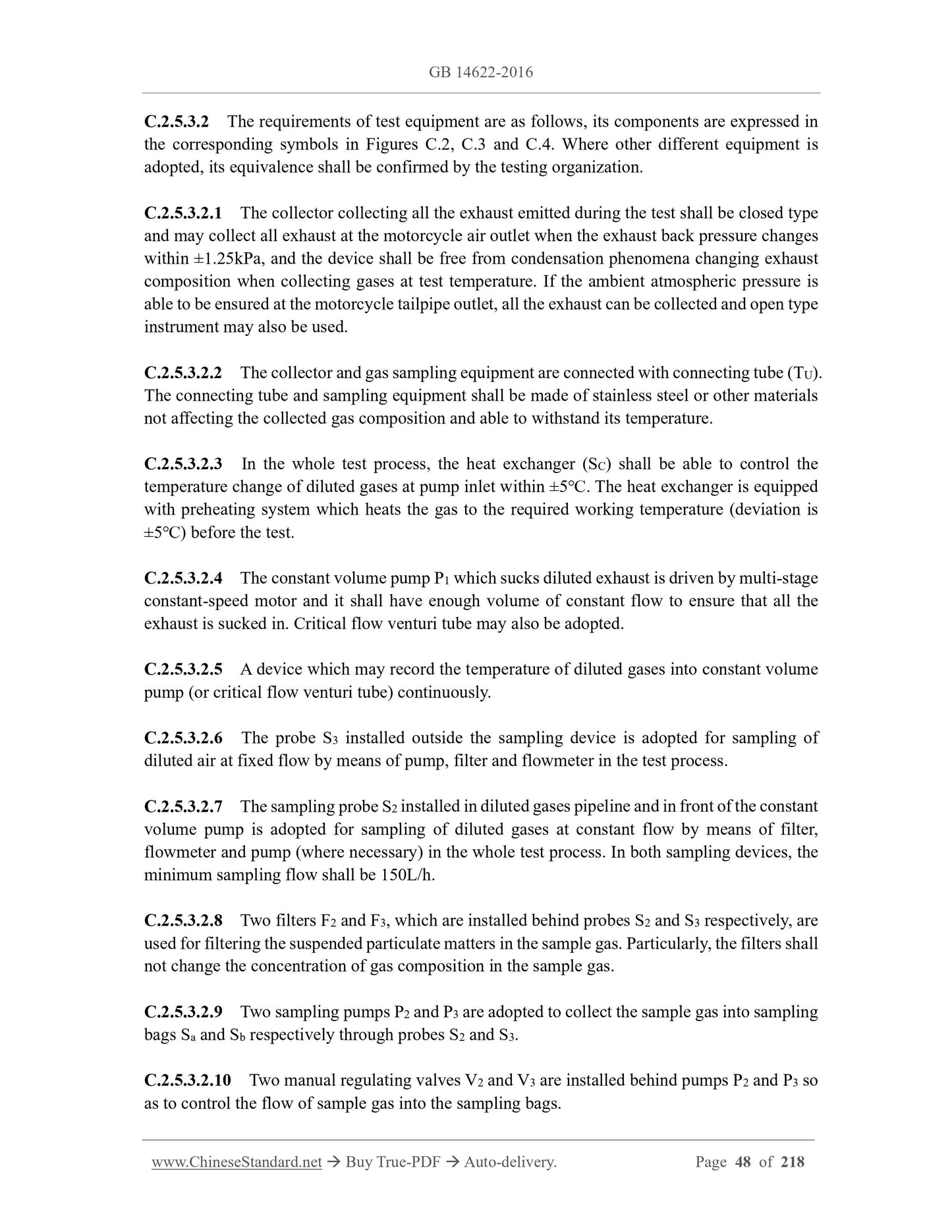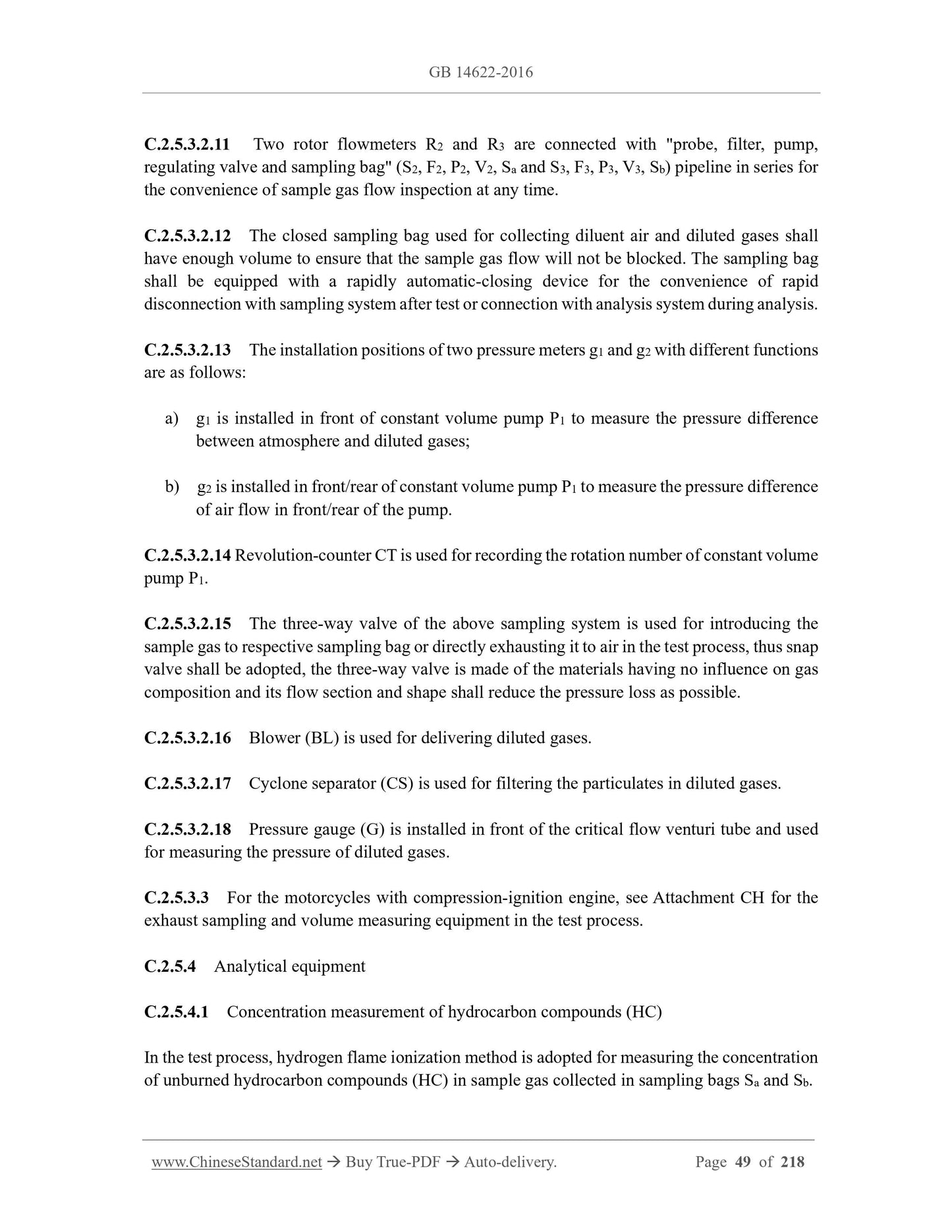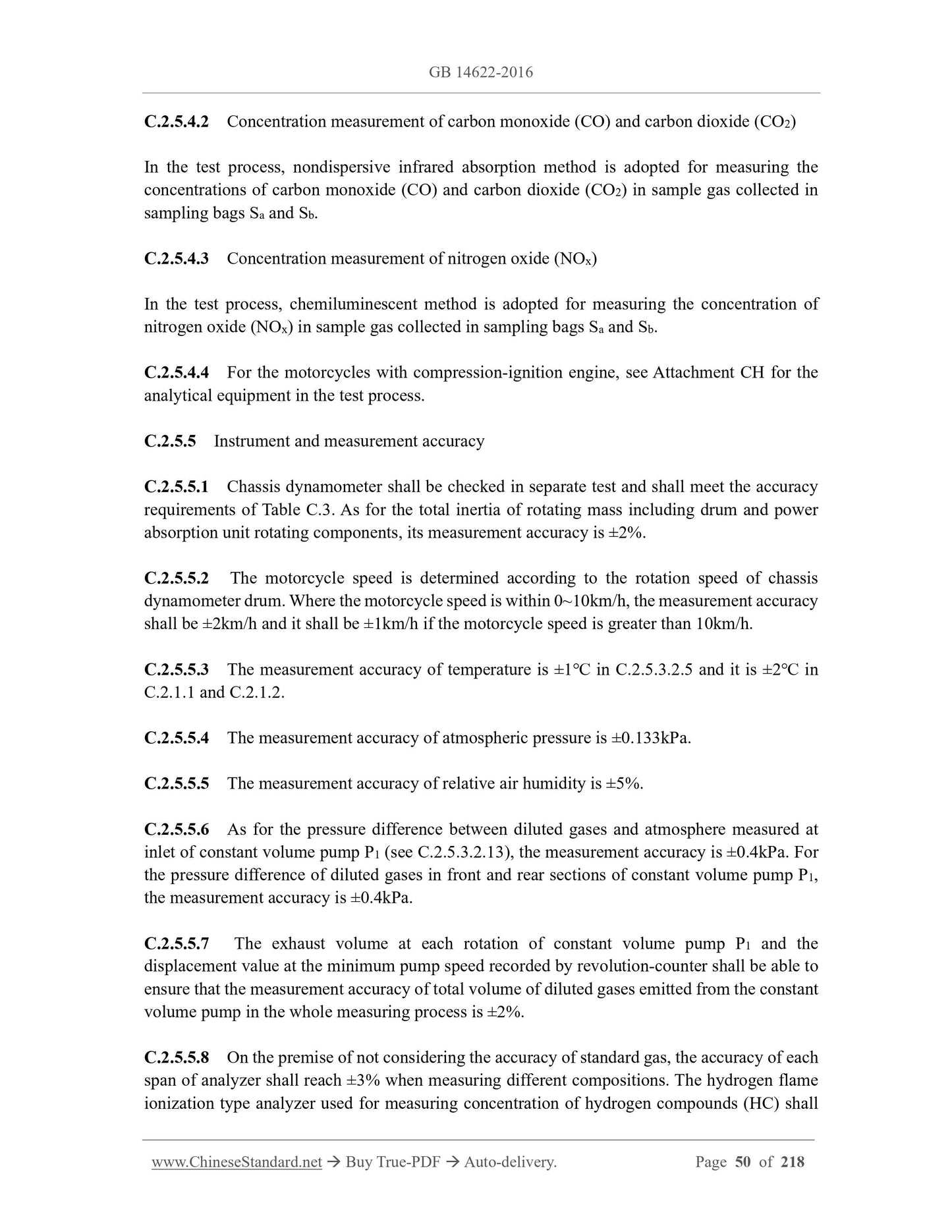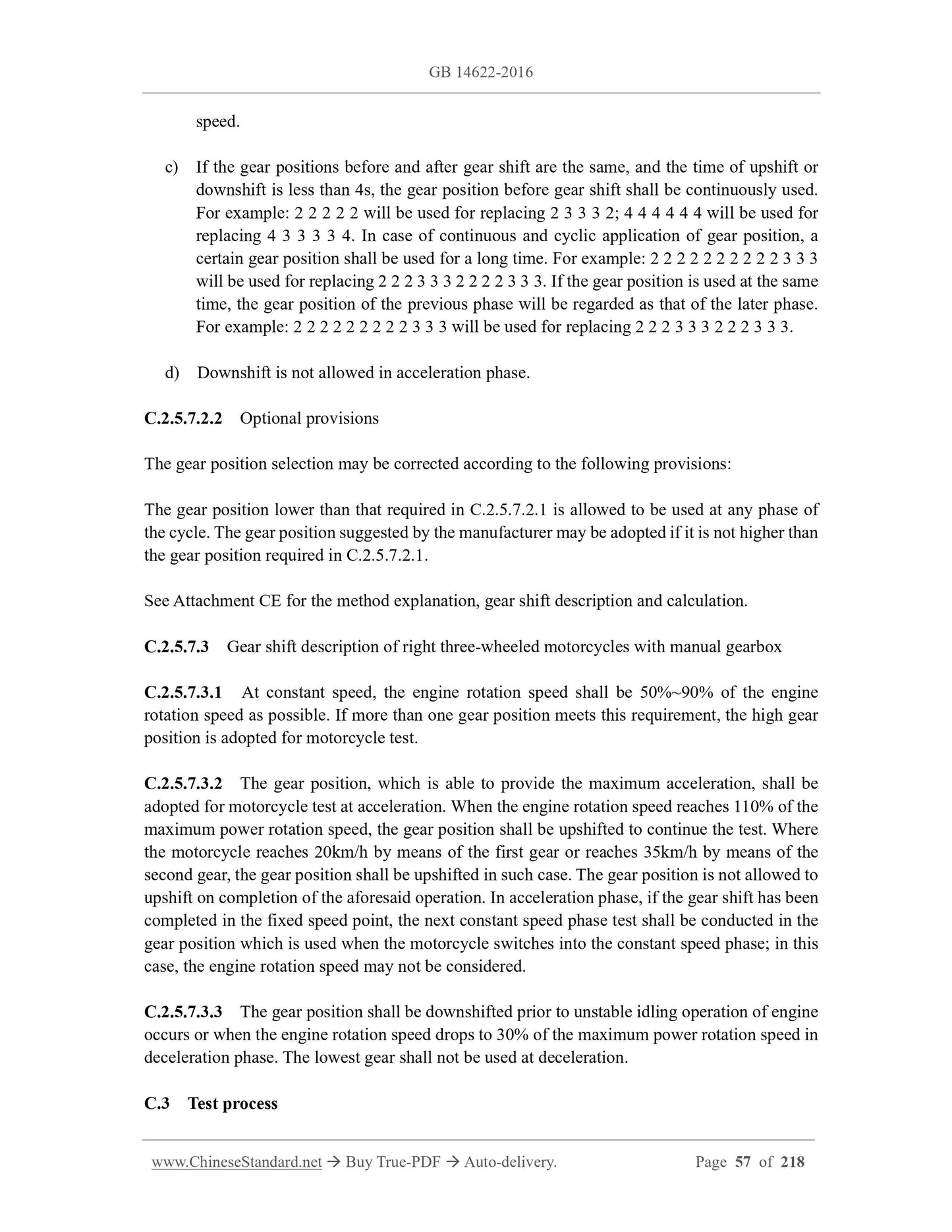1
/
de
12
PayPal, credit cards. Download editable-PDF and invoice in 1 second!
GB 14622-2016 English PDF (GB14622-2016)
GB 14622-2016 English PDF (GB14622-2016)
Prix habituel
$1,755.00 USD
Prix habituel
Prix promotionnel
$1,755.00 USD
Prix unitaire
/
par
Frais d'expédition calculés à l'étape de paiement.
Impossible de charger la disponibilité du service de retrait
Delivery: 3 seconds. Download true-PDF + Invoice.
Get QUOTATION in 1-minute: Click GB 14622-2016
Historical versions: GB 14622-2016
Preview True-PDF (Reload/Scroll if blank)
GB 14622-2016: Limits and measurement methods for the emissions of pollutants from motorcycles on the running mode (CHINA stage IV)
GB 14622-2016
GB
NATIONAL STANDARD OF THE
PEOPLE’S REPUBLIC OF CHINA
ICS 13.040.50
Z 64
Replacing GB 14622-2007 and GB 20998-2007
Partially replacing GB 14621-2011
Limits and Measurement Methods for Emissions from Motorcycles
(CHINA IV)
ISSUED ON: AUGUST 22, 2016
IMPLEMENTED ON: JULY 1, 2018
Issued by: Ministry of Ecology and Environment of the People’s Republic of China;
General Administration of Quality Supervision, Inspection and Quarantine of
the People’s Republic of China.
Limits and Measurement Methods for Emissions from Motorcycles
(CHINA IV)
1 Application Scope
This standard specifies the limits and measurement methods for tailpipe emissions and
evaporative emissions of the motorcycle with spark-ignition engine, as well as the emission
requirements for crankcase, endurance requirements for emission-control devices and technical
requirements for on-board diagnostic (OBD) system.
This standard specifies the limits and measurement methods for tailpipe emissions of the three-
wheeled motorcycle with compression-ignition engine, as well as the endurance requirements for
emission-control devices and technical requirements for on-board diagnostic (OBD) system.
This standard specifies the type test requirements, production conformity inspection, and
judgment methods for motorcycles.
This standard is applicable to the motorcycles driven by spark-ignition engine, with maximum
design speed greater than 50km/h or displacement greater than 50ml; and the three-wheeled
motorcycles driven by compression-ignition engine, with maximum design speed greater than
50km/h or displacement greater than 50ml.
2 Normative References
The following normative documents contain provisions which, through reference in this text,
constitute provisions of this standard. For undated references, the latest edition of the referenced
document applies
GB/T 15089-2001 Classification of Power - Driven Vehicles and Trailers
HJ/T 289 Equipment Specifications and Quality Control Requirements for
Gasoline Vehicles in Two-Speed Idle Exhaust Emission Test
QC/T 1003 Determination of Precious Metal in Metal Support Catalytic Converter
for Motorcycles
ISO 2575: 2010 Road Vehicles - Symbols For Controls, Indicators and Tell-tales
ISO 9141-2 Road Vehicles - Diagnostic Systems - Part 2: CARB Requirements for
Interchange of Digital Information
ISO 14229-3 Road Vehicles - Unified Diagnostic Services (UDS) - Part 3: Unified
Diagnostic Services on CAN Implementation (UDSonCAN)
3.13
crankcase emissions
the gaseous pollutants exhausted to the atmosphere through the vent hole of the crankcase or the
opening of the lubrication system
3.14
evaporative emissions
the hydrocarbon compound vapor discharged from the fuel (gasoline) system of motorcycle
except that from motorcycle tailpipe, including:
diurnal breathing loss: the hydrocarbon compounds (expressed by C1H2.33 equivalent) exhausted
due to temperature change in fuel storage tank. Hot-soak loss: the hydrocarbon compounds
(expressed by C1H2.20 equivalent) exhausted from the fuel system of static motorcycle after
running for a certain duration
3.15
volume of the carbon in canister
the volume of activated carbon in the canister
3.16
weight of carbon in canister
the filling weight of activated carbon in canister
3.17
efficient loading quality of canister
the difference between the total mass of canister after adsorbing vapor and that after desorption
3.18
bed volume of canister
the design volume of activated carbon contained in canister
3.19
initial butane working capacity of canister
the efficient loading quality of unit volume of the carbon in canister after being tested for 13
times
3.20
breakthrough point
the moment when the accumulated evaporative emission amount of fuel is equivalent to 2g
3.21
non-exposed type of fuel storage tank
the fuel storage tank which is not directly exposed to sunlight except its cap
3.22
on-board diagnostic (OBD) system
the on-board diagnostic system (hereinafter referred to as "OBD system") used for emission
control, which must possess the function of distinguishing the area with potential malfunction
and storing this information in the memory of electronic control unit in the form of malfunction
code
3.23
defeat device
a kind of device that can activate, adjust, delay or stop the operation of a component or the
function of the emission control system through measuring, inducing and responding operating
parameters (such as speed, engine rotation speed, gearbox position, temperature, air inlet branch
vacuum degree and other parameters) so as to decrease the efficiency of the emission control
system under normal service conditions of the motorcycle
The following devices are not regarded as defeat devices:
(1) the device required for preventing the engine from damage or accident or for the driving
safety of motorcycle;
(2) the device only acts at the start of engine;
(3) the device acts indeed during Type I or Type IV test.
3.24
irrational emission control strategy
the measures and methods that can decrease the efficiency of the emission control system of the
motorcycle under normal service conditions to a level not complying with the emission level
required by the type test
3.25
5.1 The parts and components having an impact on tailpipe emissions, crankcase emissions and
evaporative emissions shall be such designed, manufactured and assembled as to enable the
motorcycle under normal service condition, to comply with the requirements of this standard
despite the vibration to which it may be subject.
5.2 Technical measures must be taken by the motorcycle manufacturer to ensure that the
motorcycle meets the requirements of Chapters 6 and 7. Thus, it is regarded as able to effectively
control its tailpipe emissions and evaporative emissions within the limits specified in this
standard under normal service condition and within service life.
5.3 Any of the following measures must be taken by the motorcycle manufacturer so as to avoid
excess evaporative emissions and fuel overflow due to loss of fuel storage tank cap.
(1) Adopt the automatic opening and closing fuel storage tank cap which cannot be taken
off;
(2) Avoid the excess evaporative emissions caused by loss of fuel storage tank cap from the
design structure;
(3) Other measures leading to similar effects, e.g. adopt the fastened fuel storage tank cap,
or lock the fuel storage tank cap with the key firing the motorcycle, which can only be
pulled out when the fuel storage tank cap is locked.
5.4 All motorcycles shall be equipped with OBD systems that shall be such designed,
manufactured and installed as to identify and record the malfunction types of motorcycles
throughout the service life. Without type test, any change in the technical measures taken by the
manufacturer and the OBD system equipped on motorcycle, which may affect the emissions of
motorcycle, cannot be made. The OBD system shall be equipped with a malfunction indicator
(MI) which may be perceived by the driver quickly.
5.5 The safety of electronic control system shall meet the following requirements:
(1) Unless being authorized by the manufacturer, any motorcycle adopting electronic control
unit to control the emissions shall be able to prevent being-changed. Any pluggable chip
used for storing calibration data shall be put into a sealed container or protected by
electr...
Get QUOTATION in 1-minute: Click GB 14622-2016
Historical versions: GB 14622-2016
Preview True-PDF (Reload/Scroll if blank)
GB 14622-2016: Limits and measurement methods for the emissions of pollutants from motorcycles on the running mode (CHINA stage IV)
GB 14622-2016
GB
NATIONAL STANDARD OF THE
PEOPLE’S REPUBLIC OF CHINA
ICS 13.040.50
Z 64
Replacing GB 14622-2007 and GB 20998-2007
Partially replacing GB 14621-2011
Limits and Measurement Methods for Emissions from Motorcycles
(CHINA IV)
ISSUED ON: AUGUST 22, 2016
IMPLEMENTED ON: JULY 1, 2018
Issued by: Ministry of Ecology and Environment of the People’s Republic of China;
General Administration of Quality Supervision, Inspection and Quarantine of
the People’s Republic of China.
Limits and Measurement Methods for Emissions from Motorcycles
(CHINA IV)
1 Application Scope
This standard specifies the limits and measurement methods for tailpipe emissions and
evaporative emissions of the motorcycle with spark-ignition engine, as well as the emission
requirements for crankcase, endurance requirements for emission-control devices and technical
requirements for on-board diagnostic (OBD) system.
This standard specifies the limits and measurement methods for tailpipe emissions of the three-
wheeled motorcycle with compression-ignition engine, as well as the endurance requirements for
emission-control devices and technical requirements for on-board diagnostic (OBD) system.
This standard specifies the type test requirements, production conformity inspection, and
judgment methods for motorcycles.
This standard is applicable to the motorcycles driven by spark-ignition engine, with maximum
design speed greater than 50km/h or displacement greater than 50ml; and the three-wheeled
motorcycles driven by compression-ignition engine, with maximum design speed greater than
50km/h or displacement greater than 50ml.
2 Normative References
The following normative documents contain provisions which, through reference in this text,
constitute provisions of this standard. For undated references, the latest edition of the referenced
document applies
GB/T 15089-2001 Classification of Power - Driven Vehicles and Trailers
HJ/T 289 Equipment Specifications and Quality Control Requirements for
Gasoline Vehicles in Two-Speed Idle Exhaust Emission Test
QC/T 1003 Determination of Precious Metal in Metal Support Catalytic Converter
for Motorcycles
ISO 2575: 2010 Road Vehicles - Symbols For Controls, Indicators and Tell-tales
ISO 9141-2 Road Vehicles - Diagnostic Systems - Part 2: CARB Requirements for
Interchange of Digital Information
ISO 14229-3 Road Vehicles - Unified Diagnostic Services (UDS) - Part 3: Unified
Diagnostic Services on CAN Implementation (UDSonCAN)
3.13
crankcase emissions
the gaseous pollutants exhausted to the atmosphere through the vent hole of the crankcase or the
opening of the lubrication system
3.14
evaporative emissions
the hydrocarbon compound vapor discharged from the fuel (gasoline) system of motorcycle
except that from motorcycle tailpipe, including:
diurnal breathing loss: the hydrocarbon compounds (expressed by C1H2.33 equivalent) exhausted
due to temperature change in fuel storage tank. Hot-soak loss: the hydrocarbon compounds
(expressed by C1H2.20 equivalent) exhausted from the fuel system of static motorcycle after
running for a certain duration
3.15
volume of the carbon in canister
the volume of activated carbon in the canister
3.16
weight of carbon in canister
the filling weight of activated carbon in canister
3.17
efficient loading quality of canister
the difference between the total mass of canister after adsorbing vapor and that after desorption
3.18
bed volume of canister
the design volume of activated carbon contained in canister
3.19
initial butane working capacity of canister
the efficient loading quality of unit volume of the carbon in canister after being tested for 13
times
3.20
breakthrough point
the moment when the accumulated evaporative emission amount of fuel is equivalent to 2g
3.21
non-exposed type of fuel storage tank
the fuel storage tank which is not directly exposed to sunlight except its cap
3.22
on-board diagnostic (OBD) system
the on-board diagnostic system (hereinafter referred to as "OBD system") used for emission
control, which must possess the function of distinguishing the area with potential malfunction
and storing this information in the memory of electronic control unit in the form of malfunction
code
3.23
defeat device
a kind of device that can activate, adjust, delay or stop the operation of a component or the
function of the emission control system through measuring, inducing and responding operating
parameters (such as speed, engine rotation speed, gearbox position, temperature, air inlet branch
vacuum degree and other parameters) so as to decrease the efficiency of the emission control
system under normal service conditions of the motorcycle
The following devices are not regarded as defeat devices:
(1) the device required for preventing the engine from damage or accident or for the driving
safety of motorcycle;
(2) the device only acts at the start of engine;
(3) the device acts indeed during Type I or Type IV test.
3.24
irrational emission control strategy
the measures and methods that can decrease the efficiency of the emission control system of the
motorcycle under normal service conditions to a level not complying with the emission level
required by the type test
3.25
5.1 The parts and components having an impact on tailpipe emissions, crankcase emissions and
evaporative emissions shall be such designed, manufactured and assembled as to enable the
motorcycle under normal service condition, to comply with the requirements of this standard
despite the vibration to which it may be subject.
5.2 Technical measures must be taken by the motorcycle manufacturer to ensure that the
motorcycle meets the requirements of Chapters 6 and 7. Thus, it is regarded as able to effectively
control its tailpipe emissions and evaporative emissions within the limits specified in this
standard under normal service condition and within service life.
5.3 Any of the following measures must be taken by the motorcycle manufacturer so as to avoid
excess evaporative emissions and fuel overflow due to loss of fuel storage tank cap.
(1) Adopt the automatic opening and closing fuel storage tank cap which cannot be taken
off;
(2) Avoid the excess evaporative emissions caused by loss of fuel storage tank cap from the
design structure;
(3) Other measures leading to similar effects, e.g. adopt the fastened fuel storage tank cap,
or lock the fuel storage tank cap with the key firing the motorcycle, which can only be
pulled out when the fuel storage tank cap is locked.
5.4 All motorcycles shall be equipped with OBD systems that shall be such designed,
manufactured and installed as to identify and record the malfunction types of motorcycles
throughout the service life. Without type test, any change in the technical measures taken by the
manufacturer and the OBD system equipped on motorcycle, which may affect the emissions of
motorcycle, cannot be made. The OBD system shall be equipped with a malfunction indicator
(MI) which may be perceived by the driver quickly.
5.5 The safety of electronic control system shall meet the following requirements:
(1) Unless being authorized by the manufacturer, any motorcycle adopting electronic control
unit to control the emissions shall be able to prevent being-changed. Any pluggable chip
used for storing calibration data shall be put into a sealed container or protected by
electr...
Share
